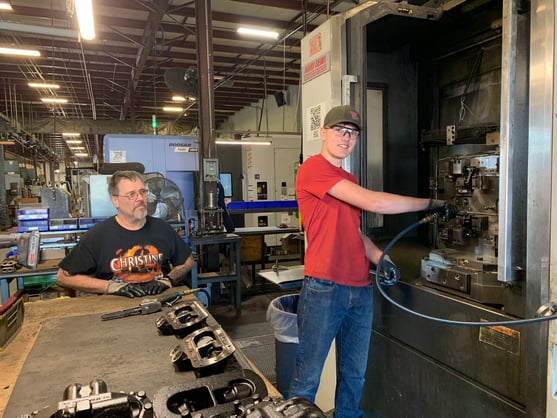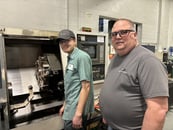Let’s start this blog with some numbers on U.S. labor. Today …
- … there are 50% more job openings than at any time before the pandemic1
- … there are 755,000 fewer people employed than pre-pandemic1
- … there has been a 3% decline in workers ages 20 to 24 since the pandemic started1
- … the unemployment rate is near a half-century low1
So, what does that mean? An unprecedented U.S. labor shortage.
While every industry is being forced to adjust, how are CNC machine shops specifically handling the challenge? Let’s dig in and find out!
First, a Big Picture Look
Modern manufacturers of all types face numerous challenges: supply chain disruption, changing regulations, capacity constraints, tariffs, climate shifts, rebound effects of the pandemic, IoT technology, and more. Not every issue spells doom and gloom, but each is a challenge.
There’s no option; manufacturers must overcome these hurdles in order to be successful in 2023 and beyond. Although manufacturing has grown overall during the last few decades, companies need workers — skilled workers — now more than ever.
Read on to hear about some potential solutions and discover how CNC machine shops, specifically, are succeeding.
Addressing the Skills Gap
Directly related to the labor shortage, there exists a gap in skills among U.S. workers that affects CNC machining. On top of that, the pandemic sparked many skilled workers to rethink how they work, where they work, and how much longer they wish to work before retirement.
Solving that skills gap isn’t simple, yet CNC machine shops have implemented various successful strategies. When possible, choices in work schedules empower workers and provide a sense of belonging while still meeting customer demands. Schedules range from traditional to flexible with overtime not available, encouraged, or mandated. Some companies incentivize overtime by paying beyond the required time and a half with rates such as double time after 48 hours worked.
Training workers can be part of a company’s culture of learning, allowing shops to optimize talent and ensuring every role is filled by people with the right skills. When someone is a good fit for their job, they’re more likely to be engaged and loyal. Plus, a robust training environment with continual learning and levels helps attract millennials and Gen Zers.
Another tactic to solve the skills gap is to partner with educational institutions to drive awareness of a CNC machining career. From area tech colleges to high schools, many talented young people take advantage of technical training and programs such as youth machinist apprenticeship programs that jumpstart careers.
CNC Machine Shops Tackle the Labor Shortage
Simply getting materials can be tricky with today’s supply chain chaos. In addition, the fight is on to find skilled workers among a labor shortage. Candidates have many options, and the competition for skilled workers continues to be fierce.
At a minimum, competitive pay, enticing benefits, and a great culture need to be offered. But that may not be enough to overcome some negative perceptions and misconceptions of manufacturing, especially with younger people. CNC machine shops can attract and retain the right workers by offering a clean, climate controlled, high-tech environment with well-stocked break rooms and other amenities.
Use of automation helps all types of manufacturing companies produce more high-quality, reliable products in less time. This efficiency is crucial to gain a quality edge and increase productivity. Industrial robotics not only attract young workers because of their “coolness” factor, but they reduce physical strain as well. Repetitive, physically demanding work is a concern, as is safety. While robots don’t replace workers, they do handle repetitive tasks that many people can’t or won’t do in a CNC machine shop.
Driving new technologies throughout the company, helps redefine manufacturing careers. Companies that continually push the adoption of new technologies allow employees to engage with cutting edge equipment from machine centers to automation and ERP. Manufacturing employees get hands on experience and become experts working with modern equipment. These leading edge manufacturers can push like Ted Toth, IMTS Top Shops panelists to redefine manufacturing careers as "blue-tech" rather than "blue collar."
One often overlooked factor that shows itself on the shop floor are the processes used to monitor and manage the machine shop. The right processes make work clear and achievable for employees, and CNC tasks — loading, deburring, setup, audits, changing — set employees up for success. Following consistent processes for new work, engineering change requests (ECR), and scheduling reduces production teams’ stress levels and prevents inventory issues. Strong processes set Stecker Machine apart, which was recently honored as a 2022 Top Shop for “shopfloor practices & performance” by the editors of Modern Machine Shop.
Lastly, present-day young people demand that their employer be involved with sustainability initiatives. Humanity’s future is uncertain, and a focus on balancing people, planet, and profitability is attractive, even for manufacturing facilities. Limiting waste and taking care of the local environment helps the company, employees, community, and the world.
Now you know how labor shortage challenges are being solved. What machining challenges do you have that a CNC machine shop’s expertise can solve? Click the link below to download our CNC machine shop guide, contact Stecker.
1 The Washington Times, An Unprecedented Labor Shortage, July 20, 2022







